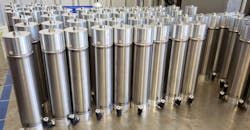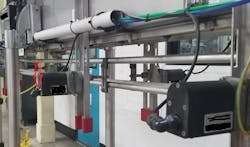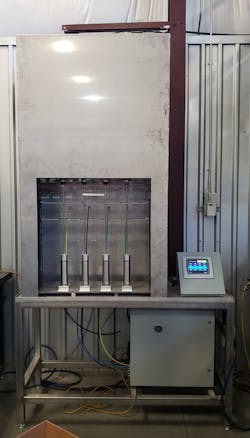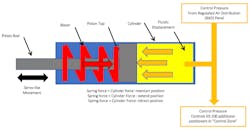Simple Device Solves Complex Positioning Problems
Moving a single object precisely, accurately, and repeatably to several positions can be challenging; moving hundreds or thousands of copies of the same thing to the same position and just as accurately is far more challenging and often impractical with most common positioning technologies. Similarly, adjusting a guide that’s a few inches long can be relatively simple with a servo, but what if the guide is a quarter-mile long and you lack a NASA-sized budget?
The Packaging Challenge
The packaging industry was faced with this challenge when advances in bottle blow molding made it possible to move a variety of bottles and sizes on the same machinery and lines that were once dedicated to one or two product sizes. Factory owners eventually wanted these lines to automatically adjust to any product size. This may sound simple, but keep in mind that a typical high-speed bottle blow-molding line is 500 to 1,000 ft long. How were line operators supposed to adjust guide rails down the entire length of that line accurately, precisely, and within a reasonable amount of time?
At first, two-position pneumatic cylinders were used; however, about six cylinders for every ten feet of conveyor were needed down the line for each product. Building a line that could handle five different products required 30 cylinders every 10 ft and there was no space for any more. To make matters worse, each cylinder needs two air lines, so multiply that by 30 for each 10-ft section of conveyor, and you end up with a bird’s nest of air lines.
Multi-position pneumatic cylinders helped reduce the space requirements and slightly lowered the number of airlines, but the stroke length of each cylinder position was still fixed. As advances in blow molding led to new products frequently being added to existing lines, the two-position and multi-position cylinder lines had to be retrofitted to accomodate each upgrade.
Misguided Efforts
This led companies to develop new ways to adjust the guides. Most turned to servo or stepper motors, but installing a servo every few feet for 500 to 1,000 ft was often more expensive than the entire conveyance line. They also brought a host of new problems. For example, all those wires and control nodes are susceptible to damage in industrial settings. Plus, electrical noise and harsh conditions cause premature failure.
The more wires in a positioning system, the more likely there is a break in at least one of them.
In one spectacular experience, we witnessed an installer manually tighten the set screws on all the pinion gears on an adjustable conveyance line with 500 stepper motor-driven positioners. When the line was fired up, metal parts began raining on the floor. Apparently, there was binding, and with nowhere for the force to go, parts just began breaking. Even minor damage to electronic systems require a level of technical expertise to fix—an expensive resource for many plants to have on hand “just in case.”
Still, other companies tried using purely mechanical approaches such as common shafts with a rack-and-pinon gear at each positioning location, or chains and cables that would engage a variety of mechanical cams and mechanisms to position. These mechanical adjustments can be reliable for short distances but fail over long distances. The problem is these mechanical adjustments rely on some type of mechanical linkage between positioning locations. But practically any cost-effective mechanical linkage material stretches elastically. Over a long-enough distance, this elastic deformation can span inches or more.
Going back to 1869, train engineers were all too familiar with the tendency for brake linkages between train cars to stretch. Early train brakes used linkages and cables, which worked fine when trains only had a few cars. But if the train was long enough, the linkages would stretch so much that cars towards the back would not brake. This resulted in a host of deadly train accidents. The issues that caused early train brakes to fail are the same as those that caused early guide-rail positioners to fail.
New Approach
The fascination began after reading an article about Westinghouse’s air brake for trains—a spring engages the brake and air pressure disengages it. That way, if a car became disconnected, so too would the air line and the car would stop. Using this as inspiration, we invented a positioner that could be used to move and hold a variety of things in place, including line rails used to move empty bottles and boxes.
Biasers, usually springs that constantly put a force on the piston, are checked at the factory to ensure they are accurate.
The new positioners, dubbed Anysize, are generally comprised of a precise, high-rate wire coil spring “biaser” which provides a bias force on a piston within a cylinder. This piston is attached to a rod which protrudes from the cylinder end. The volume within the cylinder on the side of the piston containing the spring is vented to atmosphere. Opposite the piston is a volume filled with a fluid; for most applications this is simply compressed air. Air pressure is varied, which affects the force applied by the piston against the bias spring. The piston and rod move based on how much force (pressure) is applied to the spring. According to Hooke’s law, pressure is proportional to position.
Fluidic displacement for most applications is compressed air, however, hydraulic displacement also works and is included within the Anysize patent portfolio as long as the pressure is accurately controlled. The benefits of using hydraulics in lieu of pneumatics are stiffness and greater force. In practice, hydraulics are not used yet because the technology was developed for the food and beverage industry where end-users are concerned about contamination from hydraulic oil.
The Anysize positioner only ha a single moving part, the piston. In this version the spring acts as the biaser and air pressure controls the device.
Biaser is the terminology we typically use to describe the spring that puts the force on the piston displace, but it can be anything that changes length proportionally to force. Wire coil springs are ideal because they are relatively easy and cost-effective to make precise springs. When engineered correctly, wire coil springs have an infinite life cycle and the spring rate does not change over time. They also tend to have a mostly linear displacement. The downside to wire springs is that they can take up more space than other biasers.
“Efficiency” is a term used to describe the ratio of positioner length to stroke. Other biasers may be used when efficiency is critical. Compressed gases, for example, can be used in a very-high-rate biaser that takes up a fraction of space as a typical wound spring. The downside to gas springs is that they are susceptible to failure from leaking, may change with temperature, and the force is not linear to displacement. Other biasers may consist of a magnetic and a mass on a cam.
Because the positioner we were developing would be used in applications required hundreds of them acting in unison, air pressure was chosen, because changing pressure in a single line changes the pressure going to each positioner at the same time.
Moving beyond Westinghouse’s invention, we precisely match the springs and the pressure so that the positioners continue to move in unison to a desired position. In essence, pressure equals position. A long line of Anysize positioners can easily be controlled by a manual pressure regulator and recent developments in proportional pneumatic regulators make it possible to precisely control air pressure electronically from a PLC and integrate hundreds of positioners into a system.
Benefits
Anysize positioners enjoy the distinct advantage of simplicity over all other known linear positioning methods. The piston is the single moving part on most of them, although some variations have several pistons for increased stroke or accuracy. One single air-line controls 50 or more positioners. Control is by pressure regulation and feedback is built in to each positioner via the biaser. Small systems can be controlled by a simple manual pressure regulator. There are no wires, wire harnesses, control nodes, or concerns about electrical noise. The system is intuitive and easy to use. Thanks to the simplicity of the device, they are easy to retrofit on existing equipment.
Another key advantage is that it has built-in compliance, the ability to deform elastically when subjected to unexpected forces. Binding and other unexpected mechanical issues can stop and damage other linear actuators, which becomes become more common the more actuators there are working together. Force must be absorbed somewhere, or else parts fail. Servos and stepper motors can destroy themselves if something prevents them from moving. (The example of the pinion set screw earlier in the article is not an uncommon failure mode.) Anysize positioners have a built-in spring, inherent to their operation, that deflect if the force is great enough and then spring right back into position as soon as the force is removed. Positioners are sized such that the force required to deflect the spring is far greater than the forces applied by the objects positioned.
Energy efficiency is a common concern with pneumatics, particularly in the automotive industry. Although it’s true that a cycling electronic actuator saves energy compared to a cycling pneumatic cylinder, this is not the case when the position must be held for a period of time.
The average Anysize system consists of 300 positioners, most move to a position and stay there for a day or more. It takes approximately one cubic foot of air at 80 psi to move to a position. Once in position, it takes no energy to hold position as long as common practices are followed to minimize air leaks.
Comparatively, electronic actuators require power to move and hold position. Food and beverage plants, where Anysize is most common, almost always have abundant compressed air to power them. For plants without compressed air, however, most Anysize systems require only a fractional-horsepower compressor that can be installed inside the positioner’s control panel.
Aside from energy efficiency, using compressed air means Anysize positioners can be used in plants with harsh environments, including extreme explosion risks. Internal components are almost always non-ferrous and there are no electronics to meet the strictest non-spark explosive environment requirements. That’s one reason Anysize is used in paint factories. When vented to an outside room, it’s also easy for the new positioner to meet the strictest aseptic and washdown requirements. This makes it ideal for pharmaceutical and clean room applications. The positioners will even work when fully submerged.
Another advantage stems from Anysize’s extreme simplicity which has helped make it the most affordable yet reliable linear positioning device on the market. Simple design means few parts and ease of manufacturing.
As this configuration shows, both positioners are controlled by a single air line. One air line can control at least 50 Anysize positioners.
Most Anysize devices are based on existing mass-produced pneumatic cylinder designs and use is similar to that of typical pneumatic cylinders. They share the same durable, industrial quality.
Inexpensive servos and stepper motors for linear positioning, on the other hand, are consumer-grade products not suitable for industrial applications. And industrial grade servos and stepper motors cost on average three times the price of an Anysize system. Electronic actuators typically have many more moving parts, required wires, and a controller for each actuator.
Manually operated Acme threaded rod and gearbox systems average about twice that of Anysize. All other methods of linear actuation need more parts and are more complex.
While Anysize is an excellent option for applications in which several (or hundreds) of positioners all move the same, such as in guide-rail positioning, it is not the best way to handle all positioning needs. Some features that give Anysize its benefits can be a disadvantage for other applications.
Compliance, for example, means that applying a strong enough force will result in some amount of movement. Typically, this displacement is linear to the force applied, so for example a 20 lb force may deflect a positioner 0.05 in., and a force of 40-lb force will deflect it 0.1 in. Common tasks for Anysize are adjusting rails which guide different sized empty boxes or bottles. These items require little force to guide. In fact, when you consider an empty plastic bottle, a 20-lb force would easily crush it and the minimal amount of deflection at this force is well within the tolerance required for guiding.
But Anysize is not limited to positioning just light-weight items. They are also used to position guiderails moving fully-filled bottles and boxes. Such applications exert higher forces on the positioners, but the amount of deflection is still well within the tolerances required for guiding these products and thus does not affect operation. Even heavy objects such as entire conveyors are moved with Anysize; however, deflection due to the weight of the object positioned must be accounted for.
For example, to lift a 100-lb conveyor section with a positioner that has a 200 lb/in biaser, you would need to account for 100/200, or 0.5-in. of deflection due to the weight. Design-wise, this simply reduces the effective stroke range. Of course, if the force is in the same direction as the bias force, then it would simply require additional pressure to overcome the weight.
For a positioner that typically operates from 10 to 70 psi, it may require 20 to 80 psi, assuming it takes 10 psi to overcome the force from the weight of the conveyor. Anysize generally is not recommended for dynamic positioning—for example, shifting a gate where the force would fluctuate significantly throughout the move. Rod locks and other mechanical locks are an option for applications where positioners are moved into a position and then set. Typically, locks are used for applications such as a diverging rail guiding heavy cases where the force may fluctuate each time a case passes.
Generally, for any linear positioning device, the friction and forces acting on the item positioned must be negligible if you want precise and accurate positioning. This is particularly a concern with Anysize because forces acting on them cause some deflection. Whenever possible, Anysize positioners should attach directly to the object being positioned; this is referred to as “floating.” Avoid linkages. The added friction can cause binding and excess friction. Plus, any compliance in the linkage will make for less accuracy in the overall system.
When design constraints do not allow for a float, such as positioning from overhead with a cantilevered bracket, exterior linear bearings are recommended to prevent binding and excess friction on the positioner’s nose bearing. Anysize positioners for cantilevered loads have much larger nose bearings than other versions.
Equipping the positioner with an enlarged nose bearing like this one allows for better handling of cantilevered loads.
Currently Anysize positioners are designed to work with the compressed air constraints of typical food and beverage plants, 100 psi (max). Because pressure equates to position, the pressure regulating accuracy of commercial E-P regulators is a limiting factor. ASCO Sentronic and Festo Motion terminals are generally accurate to within 0.5 psi; for a four-inch stroke positioner, this limits resolution to 4.00/(100 psi/ 0.5) or 0.02 in. There are positioners available with multiple stages, capable of higher accuracy over longer strokes. However, this adds cost and is usually limited to special applications.
For large strokes (4 in. and above) Anysize positioners also become large when using standard low-pressure air; some 4-in. models are approximately 12-inches long. Efficiency (stroke length/overall length) diminishes rapidly for longer stroke, and generally efficiencies above 30% are desirable as it becomes awkward to fit positioners into machinery once the length becomes three or more times longer than the stroke. Leaks in the airline supplying the system can cause a pressure drop, so it is critical that any leaks are negligible and all positioners see the same pressure.
Flexibility Engineering is now developing more efficient, longer-stroke positioners that will use higher pressure air generated at the control box. This provides greater positioner stiffness and a more efficient design. For high-dynamic force applications, hydraulic fluid may be used rather than air. These positioners will have a patented “flow restricted valve.” So, the more viscous and denser the working fluid, the more resistant to movement the positioners become. Safety is also a consideration when working with higher pressure and this makes hydraulic fluid more attractive than air for these applications. Forces similar to hydraulic actuators may be possible with this technology.
Miniaturized positioners may be used for robotics, actuating miniature valves in explosive environments and other applications. Technologies similar to Anysize are currently being tested at MIT for soft robotics. These little robots deform at a rate proportional to pressure and could greatly simplify control and the mechanics of robotics.
Joseph Pawelski is vice president of technology at Anysize. For more information on packaging and material handling, call Anysize at (970) 624-6174, or visit the company's website.






